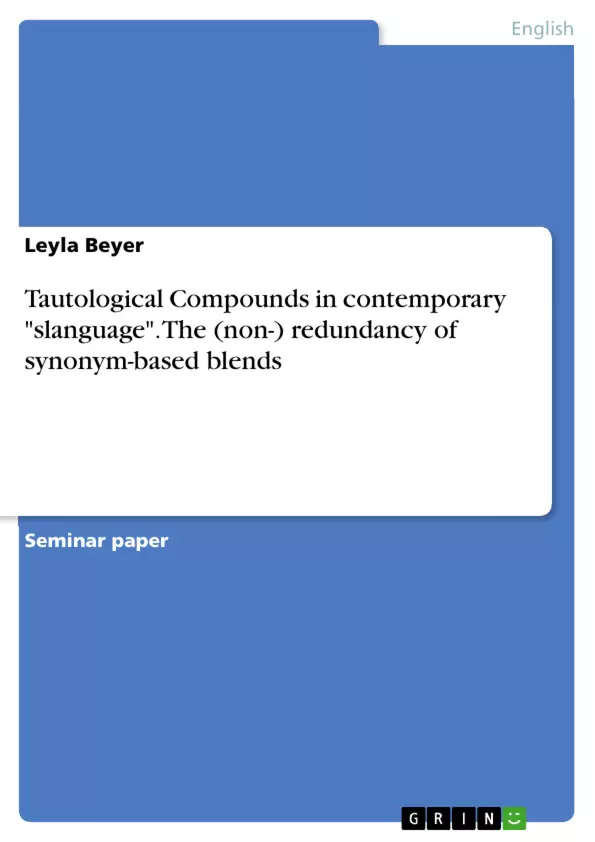This paper examines the functions of synonym-based blends in modern slang language. The objective of this work is to argue tentatively that synonym-based blends in contemporary "slanguage" serve a productive function and are not redundant in their meaning by validating the functions established by Benczes (2014) with a particular focus on synonym-based slang blends.
In English morphological literature, the term "tautological compound" is used to refer to two phenomena: For one, compounds composed of a hyponym and a superordinate term (e.g., oak tree); and secondly, compounds based upon two synonymous units (e.g., subject matter). It is commonly considered a word-formation that is redundant in its meaning and serves no semantical functions. This concept has recently been challenged by a study demonstrating that tautological compounds are far from being redundant. Much like tautological compounds, there is an abundance of slang blends in the contemporary English language whose word formation appears redundant and tautological at face value.
Table of Contents
- 1. Introduction
- 2. Tautological Compounds and their Functions
- 3. Material & Methods
- 4. Results & Discussion
- 5. Conclusion
- 6. References
Objectives and Key Themes
This paper investigates the functions of synonym-based blends in contemporary slang, challenging the notion that they are semantically redundant. The study aims to demonstrate that these blends, similar to tautological compounds, serve productive communicative purposes. This is achieved by applying and extending the functional framework established by Benczes (2014) to the specific context of slang.
- The functions of tautological compounds in language.
- The characteristics and examples of hyponym-superordinate and synonymous compounds.
- The analysis of synonym-based blends in contemporary slang.
- The challenge to the redundancy assumption of tautological compounds and slang blends.
- The exploration of semantic innovation in slang and its relationship to standard language.
Chapter Summaries
1. Introduction: This chapter introduces the concept of tautological compounds, clarifying the definition used in the paper (Benczes, 2014). It highlights the existing debate surrounding the redundancy of tautological compounds, with some researchers viewing them as informationally empty and others arguing for their functional significance. The chapter establishes the focus on synonym-based blends in contemporary slang, emphasizing the scarcity of research on their semantic functions and their potential for linguistic innovation. The primary objective of the study is presented: to demonstrate the productive function of these blends, challenging the assumption of redundancy.
2. Tautological compounds and their functions: This chapter delves into the functions of tautological compounds as defined by Benczes (2014). It differentiates between hyponym-superordinate compounds (e.g., "oak tree") and synonymous compounds (e.g., "subject matter"), explaining how each type contributes to meaning and communication. The chapter details several functions, including categorization (making explicit taxonomic relationships), upgrading concepts (elevating the significance of terms), and emphasis (enhancing emotional impact or suggesting finality). Each function is illustrated with examples from existing literature, showcasing the multifaceted roles these compounds play in language.
Keywords
Tautological compounds, synonym-based blends, slang, redundancy, semantic function, linguistic innovation, contemporary English, word formation, categorization, emphasis.
FAQ: A Comprehensive Language Preview on Tautological Compounds and Synonym-Based Blends in Slang
What is the main topic of this paper?
This paper investigates the functions of synonym-based blends in contemporary slang, challenging the notion that they are semantically redundant. It aims to demonstrate that these blends, similar to tautological compounds, serve productive communicative purposes by applying and extending the functional framework established by Benczes (2014).
What are tautological compounds?
Tautological compounds are word combinations where the two elements have overlapping or synonymous meanings (e.g., "subject matter"). The paper differentiates between hyponym-superordinate compounds (e.g., "oak tree") and synonymous compounds, exploring their functions in language.
What are the key functions of tautological compounds?
The paper discusses several functions of tautological compounds, including categorization (making explicit taxonomic relationships), upgrading concepts (elevating the significance of terms), and emphasis (enhancing emotional impact or suggesting finality).
How does this paper approach synonym-based blends in slang?
The study analyzes synonym-based blends in contemporary slang, examining their semantic functions and their potential for linguistic innovation. It challenges the assumption that these blends are redundant, arguing for their productive communicative roles.
What is the methodology of this research?
The paper applies and extends the functional framework of Benczes (2014) to analyze synonym-based blends in slang. While the specific methods aren't explicitly detailed in this preview, the Results & Discussion chapter would contain the specifics.
What are the key themes explored in this paper?
Key themes include the functions of tautological compounds, characteristics of hyponym-superordinate and synonymous compounds, analysis of synonym-based blends in slang, challenging the redundancy assumption of these compounds and blends, and exploring semantic innovation in slang and its relationship to standard language.
What are the chapter summaries provided in this preview?
The preview includes summaries for each chapter: an introduction defining tautological compounds and outlining the research objective; a chapter on the functions of tautological compounds; and a conclusion (implied, but not detailed).
What are the keywords associated with this paper?
Keywords include: Tautological compounds, synonym-based blends, slang, redundancy, semantic function, linguistic innovation, contemporary English, word formation, categorization, emphasis.
What is the target audience for this paper?
Given the academic nature of the preview (including an explicit mention of the intended use for academic analysis), the target audience is likely researchers and students in linguistics, lexicology, or related fields.
Where can I find more information?
The full paper would provide in-depth analysis and detailed methodology. The provided preview serves as a comprehensive overview, including the table of contents and key information points.
- Quote paper
- Leyla Beyer (Author), 2022, Tautological Compounds in contemporary "slanguage". The (non-) redundancy of synonym-based blends, Munich, GRIN Verlag, https://www.grin.com/document/1319068



